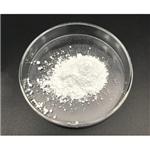Chemical Properties
white powder(s); formed when barium hydroxide octahydrate is “boiled dry” in CO2 free atmospheric; used in manufacturing oil and grease additives, soaps, and in refining beet sugar [KIR78] [MER06] [HAW93]
Uses
Barium hydroxide monohydrate is used in water purification. It is used to prepare lubricating and oil additives as well as a precursor to other barium compounds. It is also used to dehydrate and remove sulfate from various products.
General Description
Barium hydroxide monohydrate is a white powder. Barium hydroxide monohydrate is slightly soluble in water. Barium hydroxide monohydrate is corrosive to metals and tissue. Barium hydroxide monohydrate is used in water purification, to make lubricating and oil additives, to make barium containing chemicals and for many other uses.
Air & Water Reactions
The amount of heat generated by hydrolysis may be large. Slightly soluble in water.
Reactivity Profile
Barium hydroxide monohydrate reacts similarly to sodium hydroxide (NaOH), but is less soluble in water. Neutralizes acids exothermically to form salts plus water. Can react with aluminum and zinc to form oxides or hydroxides of the metal and generate gaseous hydrogen. May initiate polymerization reactions in polymerizable organic compounds, especially epoxides. May generate flammable and/or toxic gases with ammonium salts, nitrides, halogenated organics, various metals, peroxides, and hydroperoxides. Intimate mixtures with chlorinated rubber have when heated been explosive during the milling process [ABCM Quart. Safety Summ., 1963, 34, 12].
Health Hazard
TOXIC; inhalation, ingestion or skin contact with material may cause severe injury or death. Contact with molten substance may cause severe burns to skin and eyes. Avoid any skin contact. Effects of contact or inhalation may be delayed. Fire may produce irritating, corrosive and/or toxic gases. Runoff from fire control or dilution water may be corrosive and/or toxic and cause pollution.
Fire Hazard
Non-combustible, substance itself does not burn but may decompose upon heating to produce corrosive and/or toxic fumes. Some are oxidizers and may ignite combustibles (wood, paper, oil, clothing, etc.). Contact with metals may evolve flammable hydrogen gas. Containers may explode when heated.





